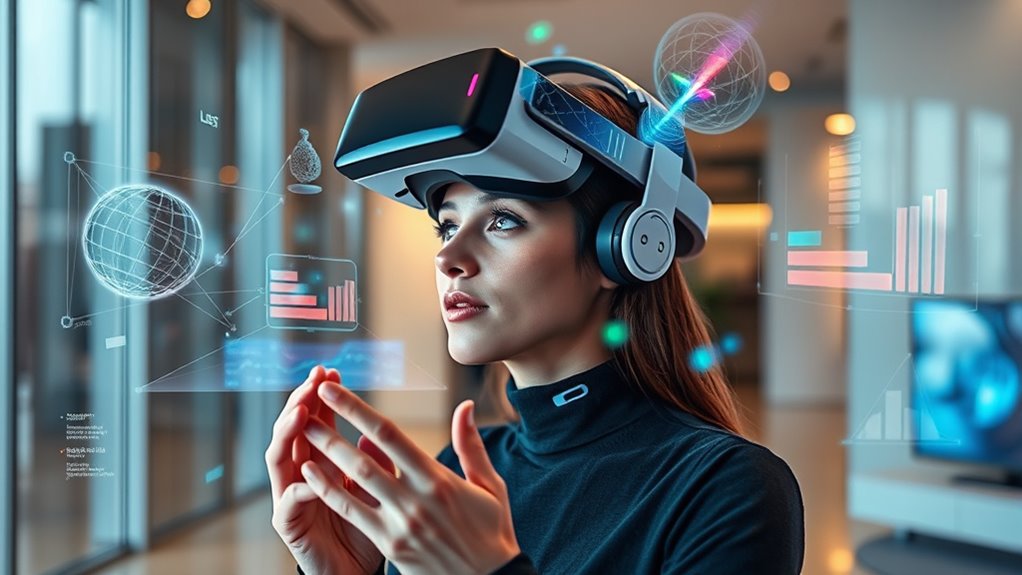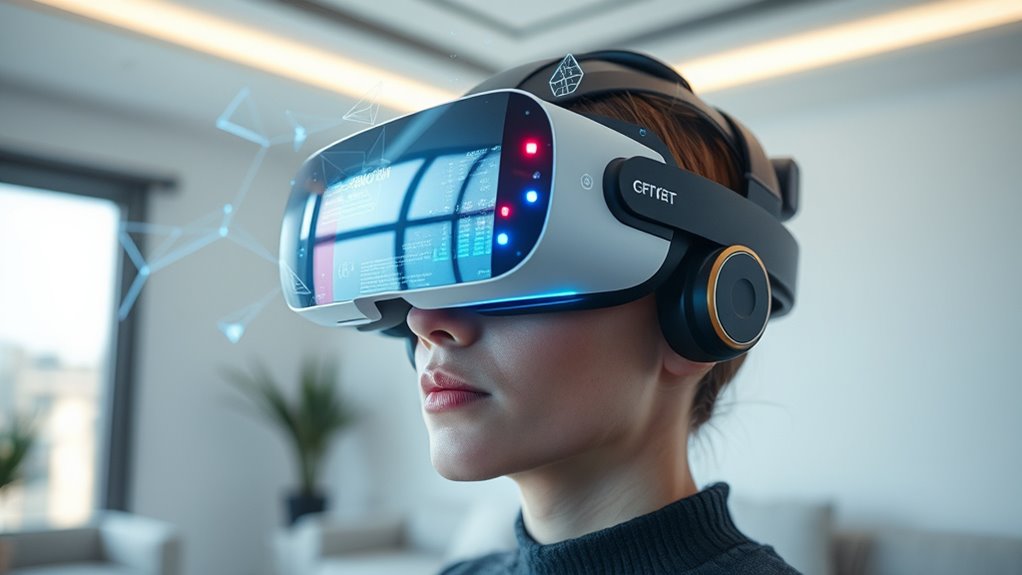Spatial computing seamlessly blends physical and virtual worlds, transforming how you interact with digital content. It moves beyond traditional screens to create augmented and mixed reality experiences where virtual objects integrate naturally into real environments. You can manipulate, explore, and communicate with digital data as part of your surroundings, making interactions more intuitive. If you keep exploring, you’ll discover how this technology is shaping industries and changing everyday experiences in exciting ways.
Key Takeaways
- Spatial computing merges physical and virtual environments, enabling immersive augmented and mixed reality experiences.
- AR overlays digital content onto real-world settings, while mixed reality allows interactive, three-dimensional virtual objects within physical spaces.
- Devices like AR glasses facilitate natural interactions with digital elements integrated into the physical environment.
- Mixed reality enhances user engagement by allowing real-time interaction with virtual objects that respond to physical movements.
- The evolution from AR to mixed reality broadens application possibilities across industries, including education, healthcare, and design.

Spatial computing is transforming how we interact with digital environments by seamlessly blending the physical and virtual worlds. This technology creates augmented environments where digital elements are integrated into real-world settings, allowing you to experience a more natural and intuitive way of engaging with information. Instead of looking at screens, you find yourself surrounded by digital data that responds to your movements and gestures, making interactions feel more immersive and authentic.
Spatial computing blends physical and virtual worlds for immersive, intuitive digital interactions.
With augmented environments, you’re no longer confined to flat displays or limited interfaces. Instead, you step into a space where virtual objects coexist with the physical surroundings, enhancing your perception and understanding of complex data. For example, you might see 3D models floating in your living room, manipulate them with hand gestures, or explore interactive maps that overlay your actual environment. These augmented environments turn ordinary spaces into interactive zones, providing contextually rich experiences that can be used for work, education, or entertainment.
Immersive interfaces are central to this shift. They allow you to engage with digital content in a way that feels natural and effortless. Through devices like AR glasses or headsets, you can look around and interact with virtual elements as if they were part of the real world. This creates a sense of presence that flat screens simply can’t deliver. For instance, in a collaborative setting, you might see colleagues’ avatars or shared digital notes floating in the air, making remote teamwork more tangible and immediate. The immersive interfaces enabled by spatial computing make it easier to learn new skills, visualize complex data, or design products by providing a more intuitive and spatially aware experience.
As you become more familiar with these systems, you’ll notice that spatial computing enables a richer, more engaging way to process information. It’s not just about viewing digital content but actively interacting with it in three-dimensional space. This shift opens up new possibilities for industries like healthcare, where surgeons can practice procedures on virtual models, or architecture, where designers walk through virtual buildings before they’re built. The blending of augmented environments and immersive interfaces forms the foundation for a future where digital and physical seamlessly coexist, transforming how you work, learn, and play in everyday life.
Additionally, understanding the importance of voiceover techniques can enhance the way immersive experiences are communicated, making them more engaging and accessible for users.
Frequently Asked Questions
How Does Spatial Computing Impact Everyday Healthcare Practices?
Spatial computing revolutionizes healthcare by enhancing medical diagnostics and patient monitoring. You can use AR and mixed reality to visualize complex data in real-time, making diagnoses faster and more accurate. It also allows you to monitor patients remotely with immersive interfaces, improving care and response times. This technology helps you deliver personalized treatments and guarantees better outcomes, transforming everyday healthcare practices into more efficient, interactive, and precise processes.
What Are the Privacy Concerns Associated With Mixed Reality Environments?
Imagine your personal data as a delicate thread woven into your digital fabric. In mixed reality environments, you face privacy concerns like data privacy breaches and unauthorized access. You must guarantee informed user consent, so your digital self isn’t exposed without permission. Protecting your data privacy means setting clear boundaries, understanding how your information’s used, and staying vigilant, so your digital world remains a safe, trusted space.
How Accessible Is Spatial Computing Technology for Disabled Users?
You’ll find that spatial computing technology is becoming more accessible for disabled users through assistive technology. Developers are working to reduce accessibility barriers by integrating features like voice control, haptic feedback, and customizable interfaces. While not perfect yet, these advancements help you interact more comfortably and effectively within mixed reality environments, making the technology more inclusive and usable for everyone, regardless of physical or sensory limitations.
What Industries Are Most Benefiting From Augmented Reality Integration?
You’ll find that retail innovation leads the way, with over 70% of retailers experimenting with augmented reality to enhance shopping experiences. Industrial automation also benefits considerably, boosting efficiency and safety. These industries leverage AR to visualize products, streamline operations, and train employees more effectively. As a result, AR integration transforms how you shop and work, making processes quicker, safer, and more engaging.
How Will Spatial Computing Influence Future Urban Planning and Architecture?
You’ll see spatial computing revolutionize urban design and architecture by enabling immersive architectural visualization. It allows you to walk through virtual models of buildings and city layouts, making planning more precise and collaborative. Future urban planning will benefit from real-time adjustments, improved stakeholder engagement, and smarter, sustainable designs. This technology helps you create more efficient, visually compelling spaces that seamlessly integrate with their environment, transforming the way you conceptualize and build cities.
Conclusion
As you step into the world of spatial computing, you’re opening the door to a universe where digital and physical blend seamlessly like a symphony. From AR to mixed reality, this technology transforms your environment into an interactive playground, making the impossible possible. Embrace this journey, and watch as your world becomes a canvas for innovation. Just like a key revealing endless potential, spatial computing invites you to explore new horizons beyond imagination.









